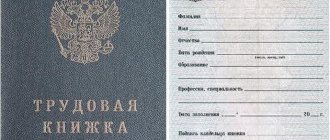Home / Labor Law / Employment / Employment contract
Back
Published: 07/13/2016
Reading time: 8 min
0
2361
The shift method of work is now very common in Russia: builders, helpers, and oil workers go to their place of work for several days or weeks and live in dormitories or change houses.
Their working conditions and salary must be clearly stated in the employment contract, which is drawn up according to the rules of the Labor Code.
- Cases of registration
- Nuances of document execution
- Document structure
- Decor
Employment contract for performing work on a rotational basis - sample
An employment contract for shift work is a document with some regulatory features. When signing it with workers who will work accordingly, it is necessary to be guided by Articles 47 and 57 of the Labor Code of the Russian Federation.
This is due to the fact that the working conditions that determine the nature of work on a shift differ significantly from those that occur when using conventional methods of work, so they must be noted separately in the agreement.
In addition, it should be noted that persons who have contraindications to this type of work cannot be allowed to work on a rotational basis. A document on cooperation with such a person is concluded only after he has undergone a special medical examination.
The contents of the document should indicate the key points of cooperation between the parties, which do not differ from the essential terms of a standard work contract and the fundamental features of such professional activity. These should be highlighted:
- Working conditions and areas where the service will be carried out;
- Salary size;
- Rights and obligations of the parties;
- Work schedule and amount and duration of rest time.
Shift work under contract: nuances
The working conditions at the Employee’s workplace are harmful in terms of the degree of harmfulness and (or) danger (class 3.2) (based on the results of certification of workplaces for working conditions dated August 15, 2013). Basic provisions on the shift method of organizing work, approved. Resolution of the State Labor Committee, the Secretariat of the All-Union Central Council of Trade Unions and the USSR Ministry of Health dated December 31, 1987 No. 794/33-82 (hereinafter referred to as the Shift Regulations).
This is important to know: Employment contract with a foreman (sample 2021)
The rotation method is a special form of work organization when using workers outside their place of permanent residence, when their daily return to their place of permanent residence cannot be ensured. Work on a rotational basis is organized according to special work and rest regimes, based on the summarized recording of working time. Working conditions when working on a rotational basis are determined by the Labor Code and other regulatory legal acts of the Russian Federation.
Those. the submitted Employment Agreement, which contains provisions mandatory by law, may be supplemented with provisions determined by the specifics of the Employer’s activities or other reasons.
Rights and responsibilities of an employee
— conclusion, amendment and termination of an employment contract in the manner and under the conditions established by the Labor Code of the Russian Federation and other federal laws;
- providing him with work stipulated by the employment contract;
— a workplace that meets state regulatory requirements for labor protection and the conditions provided for by the collective agreement [if any];
— timely and full payment of wages in accordance with their qualifications, complexity of work, quantity and quality of work performed;
— rest provided by the establishment of normal working hours, reduced working hours for certain professions and categories of workers, the provision of weekly days off, non-working holidays, paid annual leave;
— complete reliable information about working conditions and labor protection requirements in the workplace;
— training and additional professional education in the manner established by the Labor Code of the Russian Federation and other federal laws;
— association, including the right to create trade unions and join them to protect their labor rights, freedoms and legitimate interests;
— participation in the management of the organization in the forms provided for by the Labor Code of the Russian Federation, other federal laws, if any, and by the collective agreement;
— conducting collective negotiations and concluding collective agreements and agreements through their representatives, as well as information on the implementation of the collective agreement and agreements;
— protection of one’s labor rights, freedoms and legitimate interests by all means not prohibited by law;
— resolution of individual and collective labor disputes, including the right to strike, in the manner established by the Labor Code of the Russian Federation and other federal laws;
Expert opinion
Kuzmin Ivan Timofeevich
Legal consultant with 6 years of experience. Specializes in the field of civil law. Member of the Bar Association.
- compensation for harm caused to him in connection with the performance of his job duties, and compensation for moral damage in the manner established by the Labor Code of the Russian Federation and other federal laws;
— compulsory social insurance in cases provided for by federal laws;
— [other rights provided for by the current labor legislation and other regulatory legal acts containing labor law norms, collective agreement, local regulations].
— conscientiously fulfill his labor duties assigned to him by the employment contract;
— comply with internal labor regulations;
— comply with labor protection and occupational safety requirements;
— take care of the property of the Employer (including the property of third parties held by the Employer, if the Employer is responsible for the safety of this property) and other employees;
— immediately inform the Employer or immediate supervisor about the occurrence of a situation that poses a threat to the life and health of people, the safety of the Employer’s property (including the property of third parties held by the Employer, if the Employer is responsible for the safety of this property);
— [other responsibilities provided for by the current labor legislation and other regulatory legal acts containing labor law norms, collective agreement, local regulations].
Features of drawing up a contract
An employment contract for a shift worker is different from a regular agreement between employer and employee. The document must indicate the type of work, exact location, duration and working hours. The employer has the right to refer to its local act adopted to regulate work on a rotational basis.
Information about the shift must be indicated not only in the contract, but also in the employee’s work book, as well as in the order for employment. If the employee is already on the payroll, an additional document is created that establishes the transition to shift duty.
Both fixed-term and open-ended agreements are concluded with employees. According to Art. 59 of the Labor Code, a fixed-term contract is allowed to be used when performing temporary or seasonal work, as well as without specifying a period, but with a clearly defined volume. The regulation also describes a number of other situations in which a fixed-term agreement may be used.
Contents of the employment contract
The document must define the conditions for placing employees in a temporary settlement and payment for travel, if any. The employer has the right not to pay for travel to the site, but can do this at his own discretion. With all additional nuances, the contract must contain the following points:
- general information;
- employer's payment obligations;
- daily routine and rest time;
- working conditions, guarantees and compensation;
- social insurance;
- rights and obligations of the employee and the employer;
- area of responsibility of the parties;
- sequence of registration, as well as the procedure for change and termination;
- details of the parties.
The employer indicates in the document the position and department of the employee in order to eliminate inconsistencies and cases of someone else’s work being performed by mistake. The compensation specified in the contract excludes fraud and underpayments.
Work and rest schedule
Special clause of the contract
When creating a schedule, it is important to consider that this method of work uses cumulative time tracking. For example, if a person has worked in rotation for six months in total, the employer provides and pays for additional leave for 12 days
The working day should not exceed 12 hours, and there should be at least one day off per calendar week. The law does not oblige the employer to organize meals for employees - this is decided depending on the living conditions.
employment contract can be found here:
Working time and rest time
4.1. Due to the specific nature of the Employee’s activity, a summarized recording of working time is established.
4.2. The accounting period is [for example, a month, a quarter, but not more than a year]. The accounting period covers all working time, travel time from the location of the Employer or from the collection point to the place of work and back, as well as rest time falling within a given calendar period of time.
4.3. The duration of working hours during the accounting period should not exceed the normal number of working hours established by law.
4.4. Working time and rest time within the accounting period are regulated by the shift work schedule, which is approved by the Employer and brought to the attention of the Employee no later than two months before it comes into force.
Days spent traveling to and from work are not included in working hours and may fall on inter-shift rest days.
4.5. The duration of daily work (shift) should not exceed 12 hours.
4.6. The number of days of weekly rest in the current month must be at least the number of full weeks of this month. Weekly rest days can fall on any day of the week.
4.7. Hours of overtime within the work schedule on a shift, not multiples of a whole working day, can be accumulated over the course of a calendar year and summed up to whole working days, with the subsequent provision of additional days of inter-shift rest.
4.8. The employee is granted annual paid leave of [value] calendar days.
4.9. The employee is granted an additional annual paid leave of [value] calendar days [indicate the basis for providing additional leave].
4.10. For family reasons and other valid reasons, the Employee, upon his written application, may be granted leave without pay, the duration of which is determined by agreement between the Employee and the Employer.
Supplement and payment features
The assignment of monetary remuneration for rotational work differs from the standard design of remuneration under a regular employment contract. A distinctive feature is the accrual of a shift bonus to workers.
This additional surcharge can be calculated in two ways:
- as a percentage of the established salary or salary;
- a fixed amount (like accrual of travel allowances during a business trip).
The first method of calculating the premium is most often used.
Employees of budgetary and municipal institutions can count on the percentage of bonus established by law:
- an increase of 75% of wages - for individuals working in the Far North or neighboring areas;
- an increase of 50% - for persons working in the Far East or Siberia;
- 30% increase for all other regions.
To understand the process of forming payment for a shift worker’s work, let’s look at an illustrative example:
- Fixed payment for one working hour – 300 rubles/hour.
- Compensation payments – 700 rubles/day.
- Cash accrual for the time that the employee uses daily to travel to the work site is 100% of the salary for the day of work, taking into account an 8-hour work week.
The actual time worked by the employee is: 4th quarter 2021: in October - 172 hours, in November - 172 hours, in December - 172 hours. The total number of hours actually worked was 516 hours during the specified time period. Normally, 511 hours should be worked. This means that 5 hours will be paid for overtime.
Shift work is a popular and highly paid method of work. Before concluding a contract for this type of work, it is necessary to familiarize yourself with all the nuances and points at a particular enterprise. In this case, both the employer and the shift worker will be satisfied.
Final provisions
7.1. Disputes between the Parties arising during the execution of this employment contract are considered in the manner established by the Labor Code of the Russian Federation and other federal laws.
7.2. In all other respects that are not provided for in this employment contract, the Parties are guided by the legislation of the Russian Federation governing labor relations.
7.3. The employment contract is concluded in writing, drawn up in two copies, each of which has equal legal force.
7.4. All changes and additions to this employment contract are formalized by a bilateral written agreement.
7.5. This employment contract may be terminated on the grounds provided for by current labor legislation.
Features of organizing a shift during the coronavirus period
To counter the spread of the coronavirus pandemic during shift work, the Government of the Russian Federation issued Decree No. 601 dated April 28, 2020 “On approval of the Temporary Rules for Work on a Shift Method.” It must be applied by all organizations for the period from 04/28/2020 to 12/31/2020 .
Here are the main changes to consider during this period:
- If, due to restrictive measures to contain the pandemic, the new shift is late to the place of work, of the shift in connection with the coronavirus is allowed 3 months , beyond those established in Art. 299 Labor Code of the Russian Federation 3 months. Thus, during the validity of this resolution, the maximum duration of the shift can be increased to 6 months . Moreover, such actions must be carried out by agreement with employees and the trade union and formalized in an additional agreement to the employment contract. obligation to comply with the maximum duration of the shift and the minimum duration of rest between shifts is preserved . All overtime hours in excess of normal working hours during the period of extended shifts are paid as overtime .
- Downtime, the occurrence of which is associated with countering the spread of infection, must be paid in the amount of no less than 2/3 of the tariff rate (salary), calculated in proportion to the downtime.
- The 2-week isolation period for newly arrived workers on shift includes the period they are on the move. This period must be paid in an amount of at least a single tariff rate or part of the salary attributable to this time.
- deliver new personnel to the work site simultaneously ;
- 2 days before being sent on duty, employees must be tested for coronavirus;
- if an employee is found to be infected, it is necessary to prohibit him from entering the shift area and place him in isolation for 2 weeks ;
- It is not recommended to hire persons over 65 years of age .
Regulatory framework
Shift work under an employment contract is regulated at the legislative level.
An entire chapter of the Labor Code of the Russian Federation, number 47, is devoted to this issue.
Labor Code of the Russian Federation
At the same time, various articles regulate the following aspects of labor relations with shift workers:
- Art. No. 297 of the Labor Code of the Russian Federation - determines that there is a shift;
- Art. No. 372 of the Labor Code of the Russian Federation - establishes the procedure for applying the rotation method;
- Art. No. 299 of the Labor Code of the Russian Federation - determines the features of calculating working time on a shift;
- Art. No. 300 of the Labor Code of the Russian Federation - prescribes keeping records of the work and rest time of rotation workers on an accrual basis;
- Art. No. 302 of the Labor Code of the Russian Federation - establishes guarantees and the amount of compensation available to shift workers;
- Art. No. 372 of the Labor Code of the Russian Federation - determines the permissible periods of being on shift.
The provisions that regulate the relationship between the employer and the employee under the rotational method of organizing work in 2021 contain the following regulations:
- Labor Code of the Russian Federation;
- Shift regulations approved in 1987.
Sometimes it is difficult for an employer to determine whether it is worth using the rotation method. In the Labor Code you can find a list of organizations for which, in the opinion of the drafters, it is advisable to use this method of organizing work.
The rotational method is not suitable for everyone. A list of restrictions has been included in the Labor Code. According to the law, the following cannot work on shift:
- young people who have not reached the age of majority;
- women during pregnancy;
- mothers with children under 3 years old;
- fathers and guardians of children under 3 years of age who are raising children without their mother.
In addition, an employment contract for those working on a rotational basis is concluded only after passing a medical examination. An examination by a doctor is a mandatory condition for those who get a job as a shift worker. The employer does not have the right to hire people with medical contraindications.
Work and rest schedule
4.1. The duration of working hours, the beginning and end of the working day, breaks for rest and meals and other issues of work and rest are determined by the Internal Labor Regulations and other local regulations of the Company.
4.2. The duration of the shift for the Employee is set at 15 (Fifteen) days.
Expert opinion
Kuzmin Ivan Timofeevich
Legal consultant with 6 years of experience. Specializes in the field of civil law. Member of the Bar Association.
4.3. An employee has the right to annual leave while maintaining his place of work (position) and average earnings. The duration of the Employee's annual basic paid leave is 28 calendar days.
4.4. Additional paid holidays and other holidays are provided to the Employee in the manner and on the terms determined by regulatory legal acts containing labor law norms, as well as by the Collective Agreement and local legal acts of the Company in the amount of:
- for work in areas equated to the regions of the Far North - 16 calendar days;
- for hard work, work with harmful and (or) dangerous working conditions - in accordance with the Collective Agreement;
- for irregular working hours - in accordance with the Collective Agreement.
When does the contract apply?
The use of a shift method of labor organization is justified when an employee needs to spend more than three hours to get to the site. This form of work is similar to business travel, but the shift has a fundamental difference: workers live in small temporary towns or other housing rented by the employer.
We invite you to familiarize yourself with: Alimony in a fixed amount
Such a trip can last up to a month, and in special cases provided for by law, up to three. To increase the length of stay at the site, a local level normative act is drawn up, which is approved by the trade union.
Terms of payment
5.1. For the performance of his/her job duties, the Employee is assigned the VI level of remuneration according to a 17-bit wage scale, the hourly wage rate is 438 rubles.
5.2. The employee is given a regional coefficient of wages of 50%.
5.3. The employee is given a percentage increase in wages for length of service in areas equated to the regions of the Far North in the amount of 80%.
5.4. The employee is given a percentage increase in wages for work in hazardous working conditions in the amount of 4% of the tariff rate.
5.5. Remuneration and bonuses for the Employee are made in the manner established by the internal (local) regulations of the Employer and the Collective Agreement.
Other terms of the Agreement
9.1. An employee is obliged to keep a trade secret (confidential information that allows its owner to increase income, avoid unjustified expenses and maintain his position in the market, which has actual or potential commercial value due to its unknownness to third parties, to which there is no free access legally and in in respect of which the owner of such information has introduced a trade secret regime), which has become known to him by the nature of his activity or in any other way.
Cases of registration
Expert opinion
Kuzmin Ivan Timofeevich
Legal consultant with 6 years of experience. Specializes in the field of civil law. Member of the Bar Association.
Within the meaning of Article 297 of the Labor Code, employment contracts with shift workers are concluded when:
- employees travel outside their region for a certain period of time to perform certain work;
- It is not possible (or it is very costly in terms of money and time) to travel to work every day;
- the work is urgent in nature (during construction, repair, reconstruction of a facility in areas remote from the place of residence).
You cannot draw up shift contracts with the following employees:
- minors;
- pregnant women;
- mothers of children under 3 years old;
- persons who have contraindications to shift work based on the conclusion of a medical board.
The following professions are in demand for shift work:
- builders (masons, installers, crane operators, helpers, finishers);
- welders and pipelayers (for the construction of gas and pipelines);
- oil and gas workers;
- lumberjacks, landscapers, timber harvesters, pine cone collectors;
- gold miners, miners;
- carpenters, tractor drivers, bulldozer drivers, scraper drivers, grader drivers;
- geologists, telephone operators;
- service personnel (cooks, hostel wardens, waiters, maids);
- sellers, medical staff.
Who is not allowed to do this kind of work?
In Art. No. 298 of the Labor Code of the Russian Federation states that the following number of persons cannot work on shifts:
- pregnant women;
- minors;
- women with children under 3 years of age;
- men raising children under 3 years of age alone;
- guardians who care for children under 3 years of age.
What sections does it include?
employment contract for migrants
? Find out from our article.
Is there a probationary period when concluding a fixed-term employment contract? Read here.
Nuances of document execution
The shift work schedule must be drawn up so that the total overtime for the year for the employee does not exceed 120 hours .
Travel time to and from work is included in the shift period and is paid according to Labor Code standards (weekends and holidays are doubled).
Shift workers working in the Far North or equivalent areas have the right:
- receive a salary with a “northern” coefficient;
- take an additional 24 days of vacation;
- receive payment for transport downtime on the way to the place of work if it occurs due to the fault of transport services or due to weather conditions (Article 302 of the Labor Code).
In addition, the employment contract must include a work schedule: rotational (Article 57 of the Labor Code).
Shift duration
A special type of work, when work is carried out not at the place of actual residence, is common in work carried out in hard-to-reach places. Here are just some of the industries that employ shift workers:
- oil and gas industry;
- coal mining;
- logging;
- exploration of minerals and precious metals;
- laying of railway tracks;
- fishing;
- construction work on sites.
But in this case, the approval of the organization's workers' union must be obtained. The procedure for the trade union to approve an extended shift period is prescribed in Article 372 of the Labor Code.
If there is no trade union organization, the working period of a shift shift exceeding one month is considered overtime. Salaries are charged for overtime (in a larger amount).






